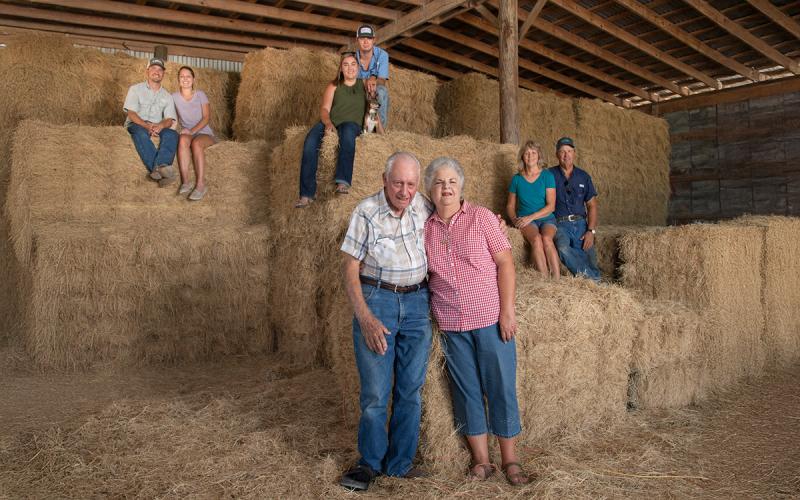Written collaboratively by Matthew Elliott, Lisa Elliott, Tong Wang and Douglas Malo.
Many U.S. states employ a use-value formula to assess agricultural lands for property tax purposes. These formulas are based on an income capitalization approach to appraisal, which values agricultural land by dividing the estimated annual net income from agricultural production (or cash rent) by a capitalization rate. Most of the use-value formulas used for valuing agricultural land in the United States are similar in that they mostly utilize annual production, price, and cash rental data from USDA-NASS and soil survey data from USDA-NRCS.
South Dakota has used a use-value formula to assess all agriculture property since 2010. To qualify as agriculture property in South Dakota, the principal use of the property must be the raising and harvesting of crops, timber, or fruit trees; the rearing, feeding, and management of farm livestock, poultry, fish, or nursery stock, the production of bees and apiary products, or for horticulture. Also, the intended agriculture gross income must be at least 10% of the assessed value, or the parcel exceeds a specified size.
We have updated an earlier soil productivity rating system (Malo et al., 1990; Malo and Westin, 1978) used by the South Dakota Department of Revenue (DOR) to assess Ag land for property tax purposes. The soil rating system is used in conjunction with the USDA-NASS annual crop data and pastureland rental data to determine Ag land assessments in South Dakota. The steps we took in updating the soil rating system is briefly described as follows:
- Develop representative crop yields and determine comparative crop rating for every soil mapping unit utilizing NRCS Soil Survey data and USDA-NASS data. The crop rating should be comparable within the individual county.
- Determine a comparative range rating based on representative useable forage amounts for each soil map unit.
- Determine a balance point factor (Malo and Westin, 1978) to equate range ratings with crop ratings.
- Determine the cropping percentage of the soil over multiple years using the USDA-NASS Cropscape.
- Develop a most probable use rating that reflects the most likely use for each soil map unit based on the soil, topography, crop yield attributes, and use patterns in the region.
- Develop an opinion of the highest and best use for each soil map unit. In determining the highest and best use, an appraiser must analyze the relevant legal, physical, and economic factors to the extent necessary to support the appraiser’s highest and best use conclusion(s) (Appraisal Foundation. 2019, Standards Rule 1-3b).
- When an income capitalization approach is necessary for credible assignment results, an appraiser must: analyze comparable rental data as are available and the potential earnings capacity of the property to estimate the gross income potential of the property (Appraisal Foundation, 2019, Standards Rule 1-4c).
More details on the background of the research, methods, and findings are available in Elliott et al. (2019).
Soil Tables Tool
We have developed a web-based tool to view the soil data, download the data by county, and to further understand the soil rating system. The Ag Land Soil Tables Tool can help appraisers make baseline agricultural land assessments and determine if adjustments from baseline are needed. The tool also allows stakeholders to understand South Dakota Ag land assessments for property tax purposes.
To use the web tool, the user can select the county of interest and the assessment year in the control tab by selecting “Controls” button on the upper toolbar. To view the data in the soil map, the user can hover their selector over the points on the map. Users can also zoom and pan over the map to examine the soil data and background base maps in more detail. Four background base maps are provided that the user can choose from-- satellite, road, dark, and a topography map. Users can alter the data that is used to color the map points by selecting the variable of interest in the control panel. The data available to map includes the baseline assessed value, the NRCS land capability class, the percent of sand silt and clay, the NRCS crop productivity index, the amount of usable forage that is expected, the expected animal units months that can be supported, the probability the soil will mostly be cropland, and the percent of the soil that has been cropped since 2010. Users can map a single soil map unit; all cropland assessed soils, non-cropland assessed soils, class IV soils, or all the soils in the county. The soil data is available for download as a .csv or Excel file by selecting the lower tabs (i.e., Table 1, Table 2, and Table 3). A more detailed description of the methods and the data in the tables can be found by selecting the “Methods” tab at the bottom of the webpage.
References:
- Appraisal Standards Board. 2018. Uniform Standards of Professional Appraisal Practice, 2018–2019 edition. Washington, DC: Appraisal Foundation.
- Appraisal Institute. 2015. The Dictionary of Real Estate Appraisal, 6th edition. Chicago, IL: Appraisal Institute.
- Elliott, M.E., L.E. Elliott, T.W. Wang, and D.M. Malo. 2019. A Change in Highest and Best Use Policy in South Dakota Has a Sizable Impact on Agricultural Land Assessments. Choices. Quarter 4.
- Justin, B.P. 2019. Valuing Rural America Foundations of Data Analysis. Glendale, CO: American Society of Farm Managers and Rural Appraisers.
- Malo, D.D., M.G. Holland, and R.J. Malo. 1990. Soil Productivity Ratings and Estimated Yields for Clay County, South Dakota. Plant Science Pamphlet #34. Plant Science Department. South Dakota Agricultural Experiment Station. ABS College. SDSU. Brookings 57007-2141.
- Westin, F.C. and D.D. Malo. 1978, Soils of South Dakota. Bull. 656. SD Agr. Exp. Sta., College of Agric. And Biol. Sci., South Dakota State University, Brookings, 57007.


